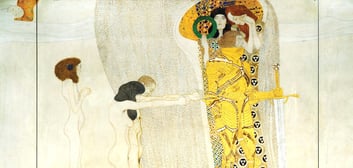In the Kiss How Does Gustav Klimt Manifest the Influence of Byzantine Art? Quizlet
Even when he was but a teenager, Gustav Klimt (1862–1918) showed signs of great talent. He was 14 years old when a relative encouraged him to take the examination for entering the Kunstgewerbeschule (the Viennese School of Practical Art) under the tutelage of main Rudolf Eitelberger von Edelberg who believed in the idea of a Gesamtkunstwerk, a total art piece of work in which all forms of art would be united and equally respected. This credo is omnipresent in Klimt'south tremendous pieces of work that combine painting, metalworking and crafts to create the unique, transcendent style nosotros know him for. Arts and crafts seem to exist something of a souvenir running in Klimt'south family: his father was a gold and silver engraver, and all three boys displayed artistic talent very early on. But one year after Klimt enrolled at the Kunstgewerbeschule his blood brother Ernst and their friend Franz Matsch passed the entrance examination and the iii of them started working together most of the time. Georg Klimt followed them ane year after only did not join what would later exist known as the 'Company of Artists'. The trio formed by Gustav, Ernst and Matsch proved to be functioning and so well that their professors did not wait for them to graduate before securing them several paid commissions: in 1879 they worked on floats for the Festzug procession that would later be known every bit the Makart Parade jubilant the royal silver wedding anniversary. A leading Viennese painter of the fourth dimension was the director of this project: Hans Makart (1840–1884), the 'Magician of Colours'. Klimt was highly influenced by Makart'south work, as were virtually of the Austrian Fine art Nouveau artists. He particularly admired the Magician's dramatic use of lite, symbolism and colours and fabricated those notions a central part of his ain work, equally they were most adequate to his exploration of such mysterious themes as the subconscious driving the many desires of the human mind. Nevertheless, Austrian contemporary painters were far from being the just ones to have influenced Klimt's art. In fact signs from every corner of the world tin can be found in the master's works: the stunning Stoclet Frieze , one of his most famous accomplishments, is overflowing with elements of Asian and Byzantine art and with symbols of the many mythologies and cultures Klimt oftentimes drew inspiration from. In The Dancer , one of the side panels of the Frieze, the position of the character can be associated with Egyptian art, every bit can be the several eyes – a recurrent motif in Egyptian mythology – that are dispersed on her ornamented dress. Connections can also be made with Ancient Hellenic republic and its astonishing mosaic frescoes. Moreover Klimt was inspired by the mosaics of Ravenna that he visited during a trip to Italian republic in 1903. His use of silver and gilded leaf is said to take begun upon his return from this trip as well. Like many artists of the Fine art Nouveau catamenia, Klimt's paintings besides accept after Japanese woodblock prints from the Edo catamenia with their flat surfaces that are paid the same detailed attention as the lifelike faces of their characters. His intriguing Portrait of Baroness Elisabeth Bachofen-Echt is a smashing example of this 'Japaneseness' that tin be found throughout his life's piece of work. Finally, one of Klimt's chief sources of inspiration is the female person form, its torso and its spirituality. Although he remained discreet and always maintained his reputation, the principal is known to accept fathered no less than 14 illegitimate children and to have entertained intimate relations with nearly of his models. Amid these endless women, ii stand out equally having marked him more than specifically. The starting time is Emilie Flöge, his blood brother'due south sis-in-law, whom he met after Ernst'southward tragic death at just 28 years old. Klimt then found himself bold financial responsibility for his late blood brother's married woman Helene and their infant girl. He soon met Helene's sister Emilie and grew particularly shut to her fifty-fifty though their relationship seems to take remained platonic throughout their lives. The second is Adele Bloch-Bauer, an upper grade Viennese adult female whose married man commissioned Klimt to paint her portrait. Adele was the but one, apart from Emilie, to accept been painted more than in one case past Klimt. Rumours of an affair between them were never verified merely Adele bears strangely similar features to Judith I , who is considered Klimt'due south nigh erotic painting, and the cryptic manner she looks at the painter through the sheet is almost evidence in itself.
The First Steps of a Principal
A Mosaic of Influences
Klimt's Women

Links
Topics: Gustav Klimt
Source: http://blog.flametreepublishing.com/art-of-fine-gifts/gustav-klimts-influences
0 Response to "In the Kiss How Does Gustav Klimt Manifest the Influence of Byzantine Art? Quizlet"
Post a Comment